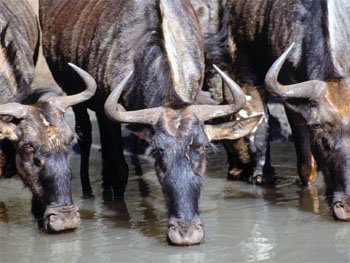Wildebeest
Less than an hour after birth, a young wildebeest can keep up with the herd.
Design

Less than an hour after birth, a young wildebeest can keep up with the herd. This ability was designed by its Creator to increase its chance for survival. Traveling in large packs makes the wildebeest safer from predators. If a predator enters the pack while it is running, the predator is in danger of being killed by the herd itself. Also when traveling, wildebeest sleep in rows. This gives them protection, as well as a quick escape in case of danger in the night.
Features
- The wildebeest is known for its pronounced muzzle and horns.
- It normally has longer, darker hair on its back and a black face, tail, and mane.
- Wildebeest are also known as gnus.
Fun Facts
- Wildebeest migrate each year to find fresh pastures. These migrating herds can contain up to one million individuals, and they sometimes include zebras and gazelles as well.
Created Kind Members
Yak, antelope, gazelle
CLASS: Mammalia (mammal)
ORDER: Artiodactyla (even-toed hooves)
FAMILY: Bovidae (cloven-hooves; two-toed)
GENUS/SPECIES: Connochaetes gnou and C. taurinus with
different subspecies (black wildebeest and blue wildebeest)
Size: 5–6 ft (1.2–1.5 m)
Weight: 300–600 lbs (140–275 kg)
Original Diet: Plants
Present Diet: Plants; mostly grasses
Habitat: Savannas of Africa
Zoo Guide
Make your next visit to the zoo more than just fun—make it factual and fascinating too! You could even start a personal “creation zoo tours” ministry. Featuring more than 100 animals, our long-awaited Zoo Guide includes beautiful pictures and explores the amazing facts and design features that point to our awesome Creator. Excellent gift for any one who loves animals!
Browse Kids Book- © 2025 Answers in Genesis
- Privacy Policy
- Contact
- About

